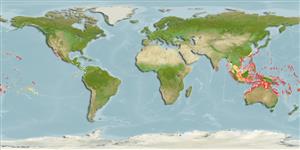Common names from other countries
>
Eupercaria/misc (Various families in series Eupercaria) >
Scaridae (Parrotfishes) > Scarinae
Etymology: Scarus: Greek, skaros = a fish described by anciente writers as a parrot fish; 1601 (Ref. 45335).
More on author: Bleeker.
Environment: milieu / climate zone / depth range / distribution range
Ecologie
marien rifbewoner; diepte 1 - 50 m (Ref. 37816). Tropical; 30°N - 28°S, 94°E - 124°W
Pacific Ocean: Cocos (Ref. 9399) and Christmas (Ref. 30874) islands in the eastern Indian Ocean; then from Moluccas to the Tuamoto and Austral islands, north to the Ryukyu Islands, south to Shark Bay and the southern Great Barrier Reef and Rapa.
Grootte / Gewicht / Leeftijd
Maturity: Lm ? range ? - ? cm
Max length : 40.0 cm TL mannelijk / geslacht onbekend; (Ref. 9137); 30.0 cm TL (female)
Dorsale stekels (totaal): 9; Dorsale zachte stralen (totaal): 10; Anale stekels 3; Anale zachte stralen: 9. Scales large. 4 median predorsal scales; 2 scale rows on cheek. Caudal fin slightly rounded in initial phase, retained in terminal males with protruding lobes giving a double emarginate effect. Lips cover or nearly cover dental plates. Initial-phase fish without canines; terminal males usually with 1 upper canine and 2 on lower. The initial phase is characterized by a series of irregular dark chevrons which may be difficult to see on dark individuals (Ref. 1602). The basic color may range from a pale gray to a deep mahogany (Ref. 1602). Large initial phase fish develop the dark greenish markings around the lip found in the terminal phase (Ref. 1602).
Inhabits lagoon and seaward reefs from 1 to over 50 m depth. Adults are common in areas with rich coral and high vertical relief (Ref. 9710, 48636). A solitary species (Ref. 90102). Juveniles may school with other species. Form feeding aggregations on rubble and mixed rubble-coral slopes rather than on flats. Females often in schools of mixed species when feeding, males usually seen separate (Ref. 48636). Feeds on benthic algae (Ref. 89972). Males exhibit territorial tendencies.
Levenscyclus en paargedrag
Maturiteit | Voortplanting | Paaien | Eieren | Fecunditeit | Larven
Oviparous, distinct pairing during breeding (Ref. 205).
Randall, J.E., G.R. Allen and R.C. Steene, 1990. Fishes of the Great Barrier Reef and Coral Sea. University of Hawaii Press, Honolulu, Hawaii. 506 p. (Ref. 2334)
Status op de Rode Lijst van het IUCN (Ref. 130435)
CITES (Ref. 128078)
Not Evaluated
Gevaar voor de mens
Harmless
Gebruik door de mens
Visserij: commercieel; Aquarium: Commercieel
Meer informatie
ReferentiesAquacultuurAquacultuurprofielKweeklijnenGeneticaElectrophoresesErfelijkheidZiektesVerwerkingMassaconversie
Tools
Speciale rapporten
Download XML
Internetbronnen
Estimates based on models
Preferred temperature (Ref.
115969): 24.5 - 28.8, mean 27.6 (based on 432 cells).
Fylogenetische diversiteitsindex (Ref.
82804): PD
50 = 0.5000 [Uniqueness, from 0.5 = low to 2.0 = high].
Bayesian length-weight: a=0.01660 (0.01096 - 0.02514), b=3.03 (2.91 - 3.15), in cm Total Length, based on LWR estimates for this species & Genus-body shape (Ref.
93245).
Trofisch niveau (Ref.
69278): 2.0 ±0.0 se; based on diet studies.
Weerstandsvermogen (Ref.
120179): Gemiddeld, minimale populatieverdubbelingstijd 1,4-4,4 jaar (K=0.22).
Fishing Vulnerability (Ref.
59153): Low to moderate vulnerability (32 of 100).
